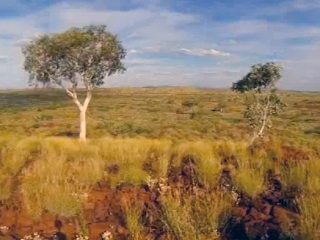 |
Geoscientists have discovered gold particles in |
See here for video:
http://www.abc.net.au/news/2013-10-23/an-gold-found-in-gum-tree-leaves/5039226
Gold found growing in eucalyptus trees in world-first CSIRO research
Geoscientists in Perth have discovered gold particles in the leaves, twigs and bark of eucalyptus trees, claiming a "eureka" moment which could revolutionise gold mining.
CSIRO researchers believe the trees, sitting on top of gold deposits buried deep underground, suck up the gold in their search for moisture during times of drought.
"We weren't expecting this at all," Dr Melvyn Lintern, a research geochemist at the CSIRO and the study's lead author, said.
"To actually see the gold particles in the leaves was quite a eureka moment for us."
Dr Lintern said the trees appear to be telling scientists what is happening under the earth's surface.
"The particular trees that we did the research on appear to be bringing up gold from a remarkable 30 metres depth, which is about the equivalent of a 10-storey building," he said.
The research group used the CSIRO's Maia detector for x-ray elemental imaging at the Australian Synchrotron in Melbourne to analyse extremely small particles at high resolution.
The portions of gold are about one-fifth the diameter of a human hair. Dr Lintern said even 500 trees growing over a gold deposit would only yield enough gold for a wedding ring.
The researchers said they have also found gold in the leaves of other trees, such as the Acacia mulga.
"We've actually found gold not only in trees but in shrubs that are growing beneath the trees as well, so (it is) not restricted to any particular trees at all," Dr Lintern said.
Discovery could make exploration cheap, quicker
The discovery, the first of its kind in the world and the first time gold particles have been found in living material, will undoubtedly generate huge interest from within the gold mining and exploration industry.
Former Newmont Mining Geochemist, Nigel Radford, says the implications for gold exploration are huge.
"A lot of this stuff has been speculated about for some time, but the identification of the gold particles in the leaf materials is completely convincing and very, very important for the future of mineral exploration," said Mr Radford, who has worked in mineral exploration his entire working life, most recently with US-based Newmont, one of the world's biggest gold mining companies.
Mr Radford believes it has the potential to make gold exploration much quicker and cheaper.
"Ideally, any mineral exploration team would like to collect their samples on-surface," he said.
"If you can sample on-surface, it saves all the cost and all the time involved in drilling holes."
Topics: science-and-technology, mining-environmental-issues, earth-sciences, business-economics-and-finance, mining-industry, human-interest, gold, kalgoorlie-6430, perth-6000, wa, australia
First posted Wed 23 Oct 2013, 2:00am AEDT



Comments
instead of people using gold the banks are creating just numbers...as u know..
so heres a thought.. if so about the gold do u actually think the banks are going ro use this..not just typing numbers in...
no ,Suzie-G it was to let you know that there is more gold out there ,that can now be retrieved very cheply, so that we can have a world currency backed b gold. Not this toilet paper that we now have backed by thin air. This is a must! Adonai
What was the purpose of this post??? get out there so they can dig more in Aussie land...
Yes saw this on the news, wont stop em digging but at least they will know where..
Suzexx